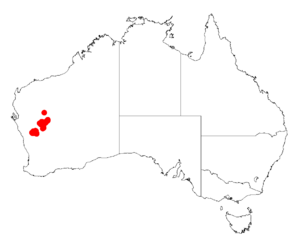Acacia speckii facts for kids
Quick facts for kids Acacia speckii |
|
|---|---|
| Conservation status | |
| Scientific classification | |
| Genus: |
Acacia
|
| Species: |
speckii
|
 |
|
| Occurrence data from AVH | |
Acacia speckii is a type of shrub or small tree. It belongs to the Acacia family, which is also known as wattles. This plant is special because it only grows in a small part of central western Australia. When a plant or animal only lives in one specific area, it's called endemic.
What it Looks Like
The Acacia speckii usually grows as a bushy, round shrub or a small tree. It can reach a height of about 1.5 to 3 meters (5 to 10 feet). Its branches are smooth and grey, shaped like cylinders.
Instead of flat leaves, most Acacia species, including Acacia speckii, have what are called phyllodes. These are like flattened leaf stems that do the job of leaves. The phyllodes of Acacia speckii stand upright and are always green. They look like thin threads, either straight or slightly curved. They are usually about 8 to 12 centimeters (3 to 4.7 inches) long and 1 to 1.5 millimeters (0.04 to 0.06 inches) wide. They have eight raised lines, or nerves, running along them.
When the plant flowers, it produces simple inflorescences. These are groups of flowers that grow alone or in pairs where the leaf meets the stem (this spot is called the axil). The flower-heads are broadly oval or oblong. After flowering, light brown seed pods form. These pods look a bit like a string of beads. They can be up to 13.5 centimeters (5.3 inches) long and 4 to 6 millimeters (0.16 to 0.24 inches) wide. Inside these pods are dull brown, round seeds.
How it Got its Name
Scientists give every living thing a special name. This helps them organize and study plants and animals. The Acacia speckii was first officially described in 1999. Two botanists, Richard Sumner Cowan and Bruce Maslin, gave it its name. They wrote about it in a science journal called Nuytsia.
Later, in 2003, another botanist named Leslie Pedley changed its name to Racosperma speckii. But then, in 2006, it was moved back to the Acacia group. This shows how scientists sometimes change classifications as they learn more!
Where it Grows
This plant is found in the Mid West and Goldfields-Esperance areas of Western Australia. It usually grows on rocky hills or rises. You can find it in rocky soils, often near or on top of rocks like granite, dolerite, or basalt.
The area where it grows stretches from around Meekatharra in the north down to Cue in the south. There are also some separate groups of these plants found further south near Yalgoo. In these areas, Acacia speckii is often part of what scientists call "mulga scrub communities."


